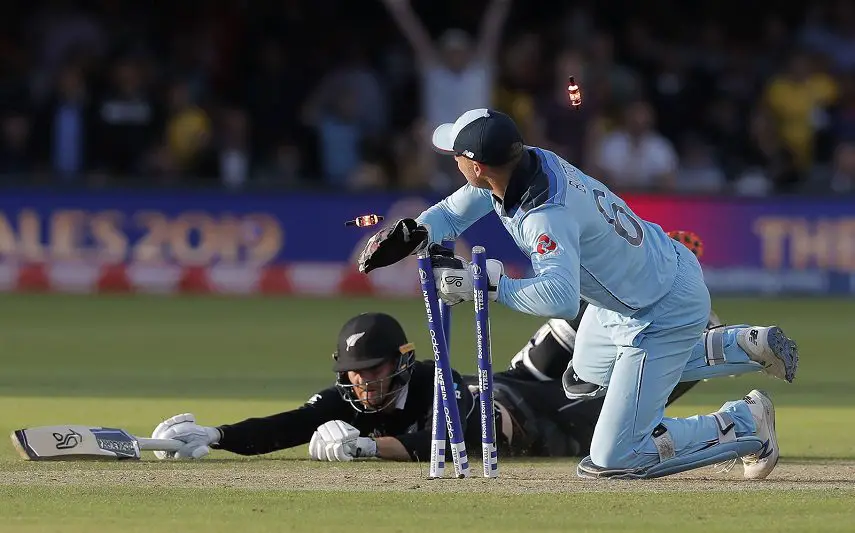Table of Contents
The basic aim in all forms of cricket is to score more runs than the opposition. Taking wickets will help to keep the opponents’ total down but teams need runs in order to win any match, either in test cricket or in any of the established limited overs formats.
But how does cricket scoring work? This guide will explain all of the ways in which runs can be allocated and this includes runs from the bat, extras and penalties.
In Short: How is Cricket Scored?
Having considered the question how does scoring work in cricket, we need to separate the way in which runs can be allocated.
In any cricket match, the majority of runs will be scored if the batsman hits the ball. Their individual aim is to add runs to their score and, hopefully, to make centuries which will advance their career. Ultimately, every run that a batsman scores will also be added to the team total which defines who wins or loses the match.
Additionally, runs can be awarded to the batting team via actions made by the bowling side:
In any game of cricket, it’s likely that the fielding team will have made a small contribution to the batting team’s total. ‘Extras’ can be separated into two sections – fielding extras and bowling extras. Finally, runs can be allocated as penalties via a range of law infringements.
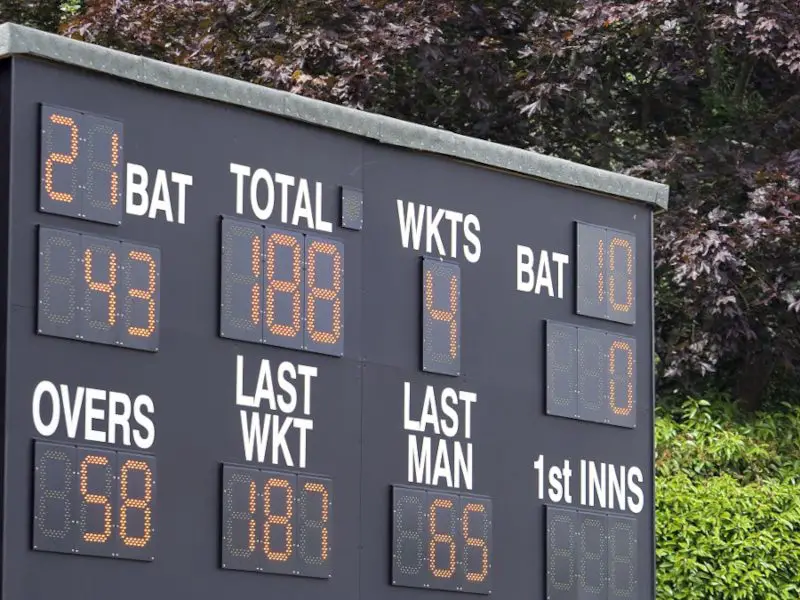
4 Ways to Score in Cricket
The score in a cricket match is determined by ‘runs’. They are the equivalent of goals in football or points in a basketball match. The object of any cricket match is to score more runs than the opposition. In the established limited overs formats of One Day and T20, the team that scores the most runs will win the game.
This concept is carried over to test and first class cricket too although there is scope for the game to be drawn. If the team batting last hasn’t reached the target to win and they haven’t lost all of their wickets, the match is declared as a draw. Runs may not, therefore, guarantee a win in test matches, but they remain important in the context of the final result.
In Summary, no matter what the form of the game may be, runs are pivotal to the outcome but how are they achieved?
1. Completing Runs
Batsmen are aiming to score runs by hitting the ball into gaps in the field. At the same time, there are two batsmen at each end of the pitch, one of them is the striker, and the other one is the non-striking batsman. After the striker hits the ball, if the two batsmen cross and successfully make it to the other end of the pitch, they will score runs, adding them to the individual and the team total. If they do this once, the batting side are allocated one run. If the batsmen successfully cross twice, they score two runs, and so on.
In theory, the batsmen can cross as many times as they like and score any number of runs, but it’s exceptionally difficult to score more than three runs in this way. In all probability, the fielding side will have retrieved the ball and thrown it back to the bowler or wicket keeper. Alternatively, it will have crossed the boundary before the third or fourth run.
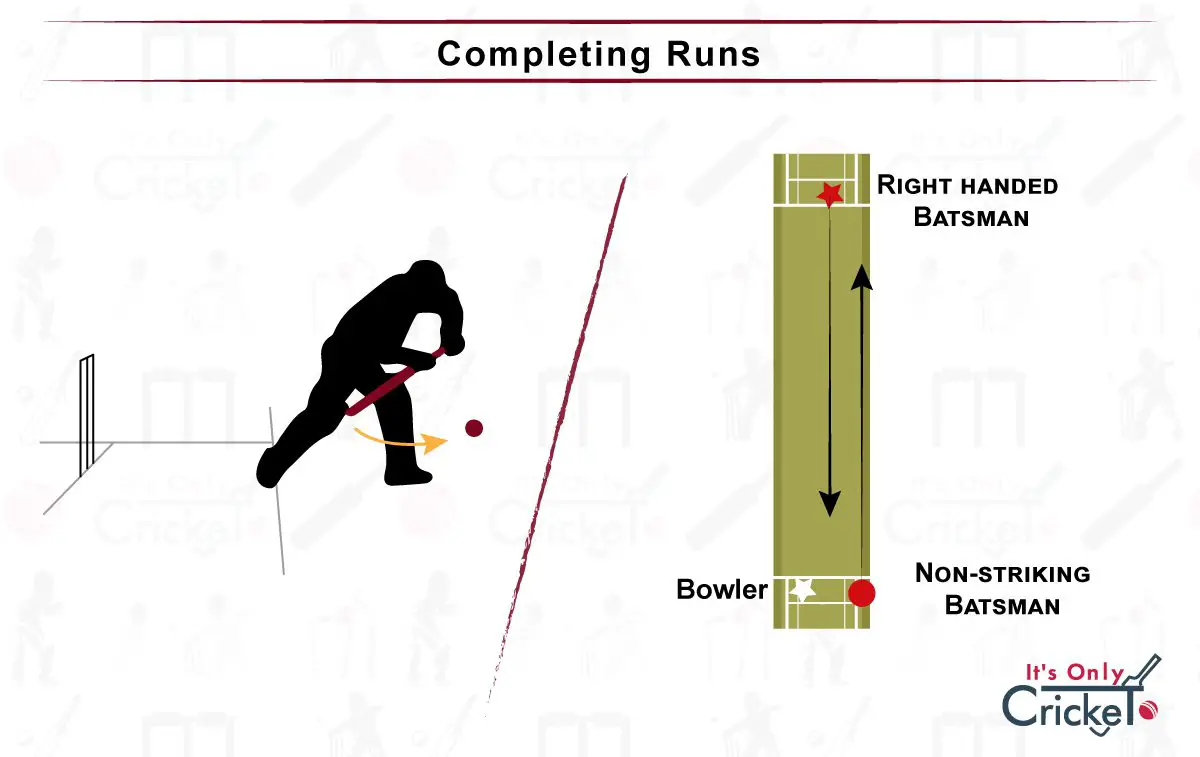
2. Hitting Boundaries
The cricket field is confined within a boundary and, if the batsman hits the ball beyond that boundary, they will score additional runs.
Four runs are scored if the ball is hit beyond the boundary and it bounces at least once before it leaves the field of play.
Six runs are awarded if the ball is struck over the boundary without bouncing before it leaves the field. Similarly to scoring a century, scoring sixes is considered somewhat of an achievement, therefore the batsmen with the most sixes are held in high regard.
It should be noted that boundary fours and sixes are not added to any runs that the batters have made. For example, if the batsmen cross once and the ball then reaches the boundary rope, only four runs will be added to the batter’s and team’s total.
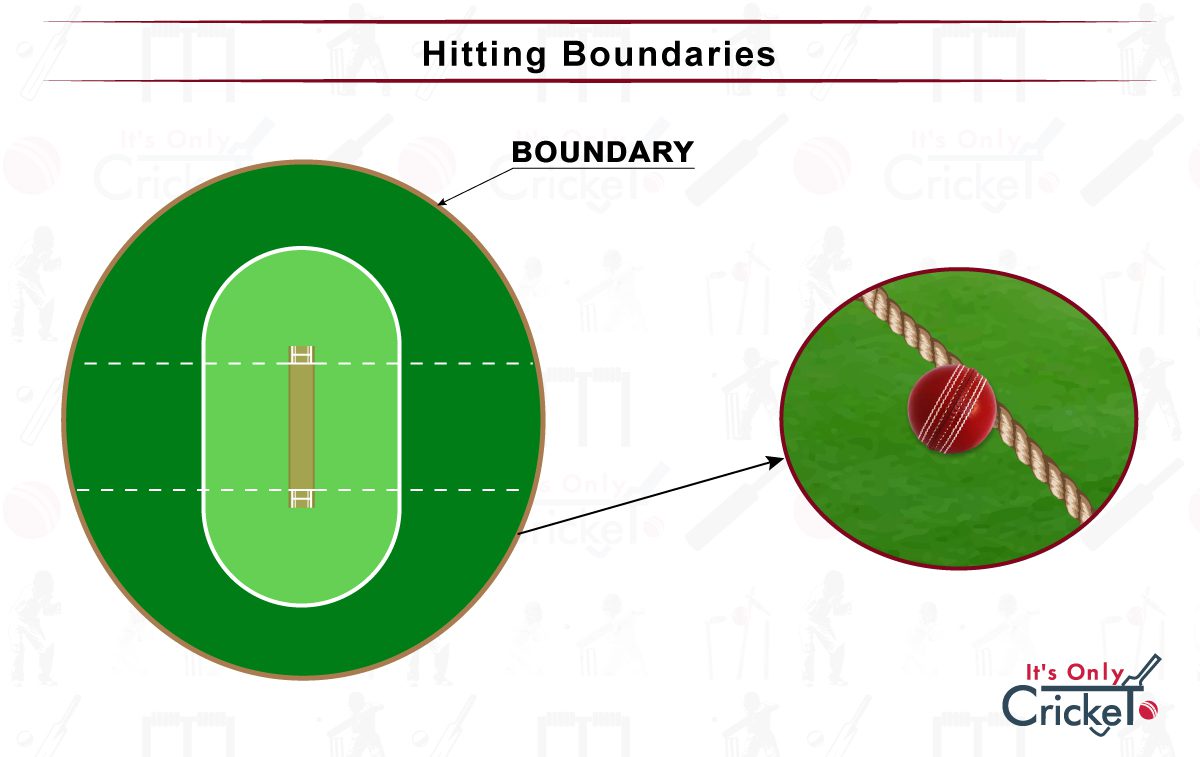
3. Losing Wickets
A lost wicket does not add any runs to either team score but it is important for a number of reasons. A team has 10 wickets intact before the game starts and, when all 10 are lost, the innings is complete and they cannot score any more runs.
Secondly, in some limited overs matches, the result can be determined by lost wickets if a game is tied. For example, a side scoring 225 for the loss of five wickets will beat the team scoring 225 runs with seven wickets lost.
The important point to note is that in professional cricket, no runs are lost when a wicket falls. This factor has been used in fun games among friends, but it doesn’t apply to official matches.
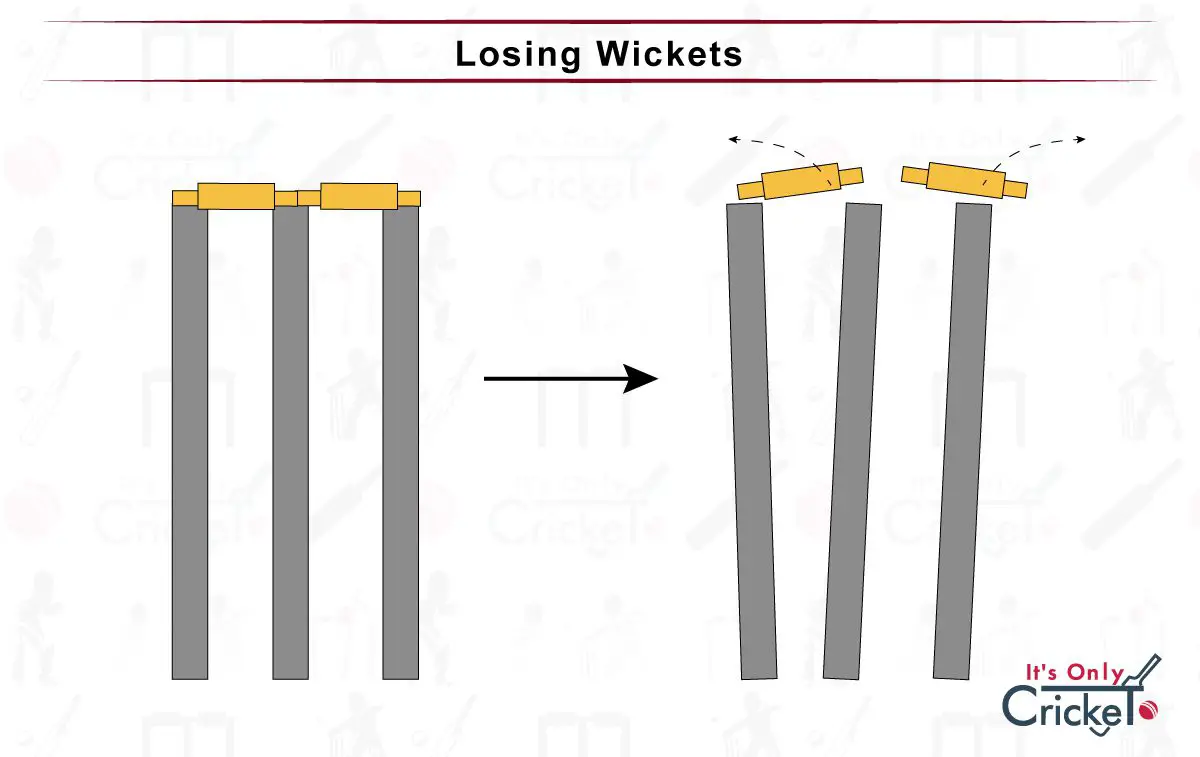
4. Extra Runs
Additional runs can be scored that don’t come from the bat. These are known as ‘extras’ and they can be split into two categories – fielding extras and bowling extras. Fielding extras are byes and leg byes and these are not debited to the bowler’s figures.
Bowling extras are wides and no balls. These add runs to the batting team and they are debited to the bowler’s figures.
Finally, there are penalty runs which can be awarded for a number of reasons. Generally, they relate to law infringements on behalf of the fielding side such as slow over rates, fake fielding or illegally fielding the ball with a cap or another part of the player’s clothing or equipment. Such penalties will be added to the total of the batting team.
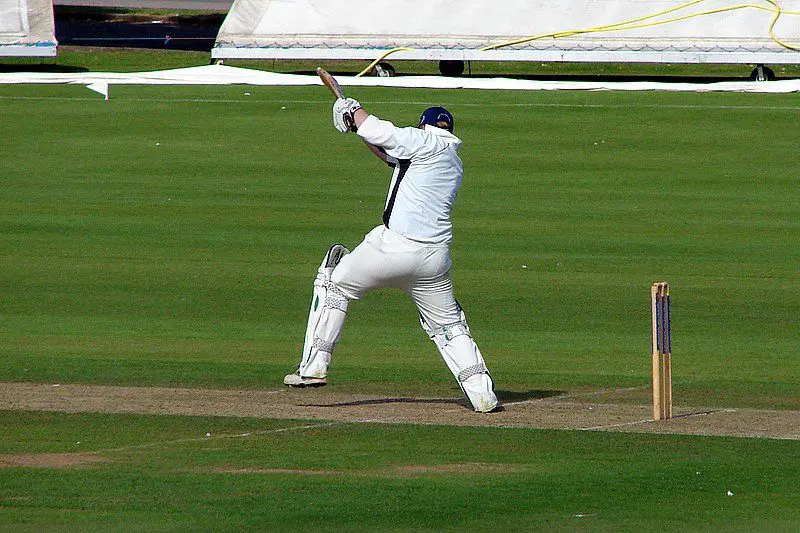
What is An Overthrow in Cricket?
Additional runs can be awarded to the batting team for overthrows. These will generally occur when the fielding team throws the ball at the stumps with the aim of running out one of the two batsmen.
If the ball travels beyond the wicket, that is the ball is “thrown over”, the batsmen are entitled to carry on running. The ball could also travel to the boundary in which case, four extra runs will be added to the batting total.
Who is Winning?
How do You Read Cricket Scores?
We’ve answered the question how does cricket scoring work but what does this mean in a match situation? Cricket enthusiasts will tell you that neither side is actually ‘winning’ until the game is over. The term isn’t widely used but we can use the scores in order to study the pattern of the match and decide who is most likely to win.
If, for example, a team has lost just two wickets and they need ten runs to win with six overs left, they are more likely to win the game. In contrast, if a side has one wicket left, with twenty-six runs needed off the final over, they are more likely to lose. This is, however, a generalisation, and we’ve seen many teams win a game from seemingly ‘lost’ positions.
Cricket Scorers and Umpires
In modern day cricket, scoreboards are constantly updated and we only need to glance at them to understand the match situation. If we are watching on television at home, the score is now permanently displayed on the screen, unless the technology has failed.
During the game, the umpires and scorers are pivotal in terms of keeping score and making sure that those scoreboards are updated correctly. As defined by the laws of the game, the umpire makes a series of signals depending on what has just happened.
For example, if the bowler has delivered a wide, he will turn to the scorers with both arms outstretched. The scorers must then acknowledge the signal.

Scorebooks and Scorecards
When a scorer acknowledges any umpire signal, they must mark it in the scorebook. Every game at professional level must have each scoring shot noted in writing and this is implemented within the scorebook.
According to the laws of the game, that scorebook must be marked in a clearly defined way and scorers at professional level will have attended courses that educate them in the practice. At professional and amateur league levels, it’s likely that each side will bring its own scorer.
At the end of the game, the scores should be verified between the umpires and each of the scorers involved. At professional level, there are unlikely to be any mistakes as the match result is confirmed by the scoreboard in real time.
At professional cricket matches, the home side may also publish a scorecard. This is a printed card with details of the two teams and space to insert information such as batsman’s runs and how they were dismissed.
A scorecard is not essential to the match itself and is generally published for spectators who want to follow the score but don’t want to write down every single detail of the game.
Average Scores in a Cricket Match
Cricket is a game where statistics play an important role and they can help us to predict the results of matches moving forward. After a certain period of time, statisticians can analyse previous games in order to determine some average scores.
If two one day internationals in a series have provided first innings scores of 350 and 300, the average is 325. And, if both of those scores have been winning totals, it may be fair to assume that a team making an above average total of 330 in the third game will have a very good chance of winning the match.
The above figures include a very small sample size and may not be enough to predict future results with any level of certainty. However, when applying average scoring, it is possible to take many other factors into consideration.
For example, if England are playing India, the statisticians may be able to take results from the previous five years of games between the two sides. This uses a bigger sample size and may be able to predict what is a good score in the future.
Average scoring can also be calculated in relation to specific grounds. As an example in this instance, let’s assume that the final of the Indian Premier League is due to be played at the M.A. Chidambaram Stadium in Chennai. In eight previous matches in the tournament, there has been a total of 1400 runs scored on first innings.
This means that the average first innings score across those eight games is 175.
Six of the eight games have been won by the side batting first. Therefore, in the final, Team A scores 185 in the first innings of the game. By using those average scores, we can see that they have a higher probability of going on to win the match.
Average scores are used mainly in One Day and T20 cricket but they can also be useful in test matches too. For example, results from The Sydney Cricket Ground may tell us that the average first innings score is 425. If South Africa bat in the next test match and make 300 on first innings, they are below that average score and may struggle to win the game as a result of that below par performance.
Importance of Analysis
All of this analysis is important to teams, and it’s certain that coaches and statisticians will know all about average scores. Before the sides go out onto the pitch, they will know what makes for a good or bad total.
Like a lot of sports, stats have become increasingly important in cricket. They are useful for spectators too, and also for those who are betting on the game. If, for example, you are staking in-play on a match, you’ll need to know all about average scores in order to make a judgement.
The amount of statistics used can be baffling at times, but they are important, and if you like numbers, it’s fascinating to study them.
Conclusion
We’ve answered the question how is cricket scored and by now, you should be able to follow a match and keep up with the total as it builds. Runs are usually scored by the batsmen who are using their bats to hit the ball into the field or beyond the boundary.
Scoring as many runs as possible in one’s career is also highly indicative of the player’s performance. Batsmen with the most runs in their career are regarded to be among the best cricketers.
Meanwhile, the fielding team can also add runs to the batting team’s total via extras such as wides, byes and leg byes. Penalty runs are rarer but this is another way in which the fielding team can add runs to the batting side’s total. Runs win matches so it’s important to study this guide and to understand how the whole system works.


